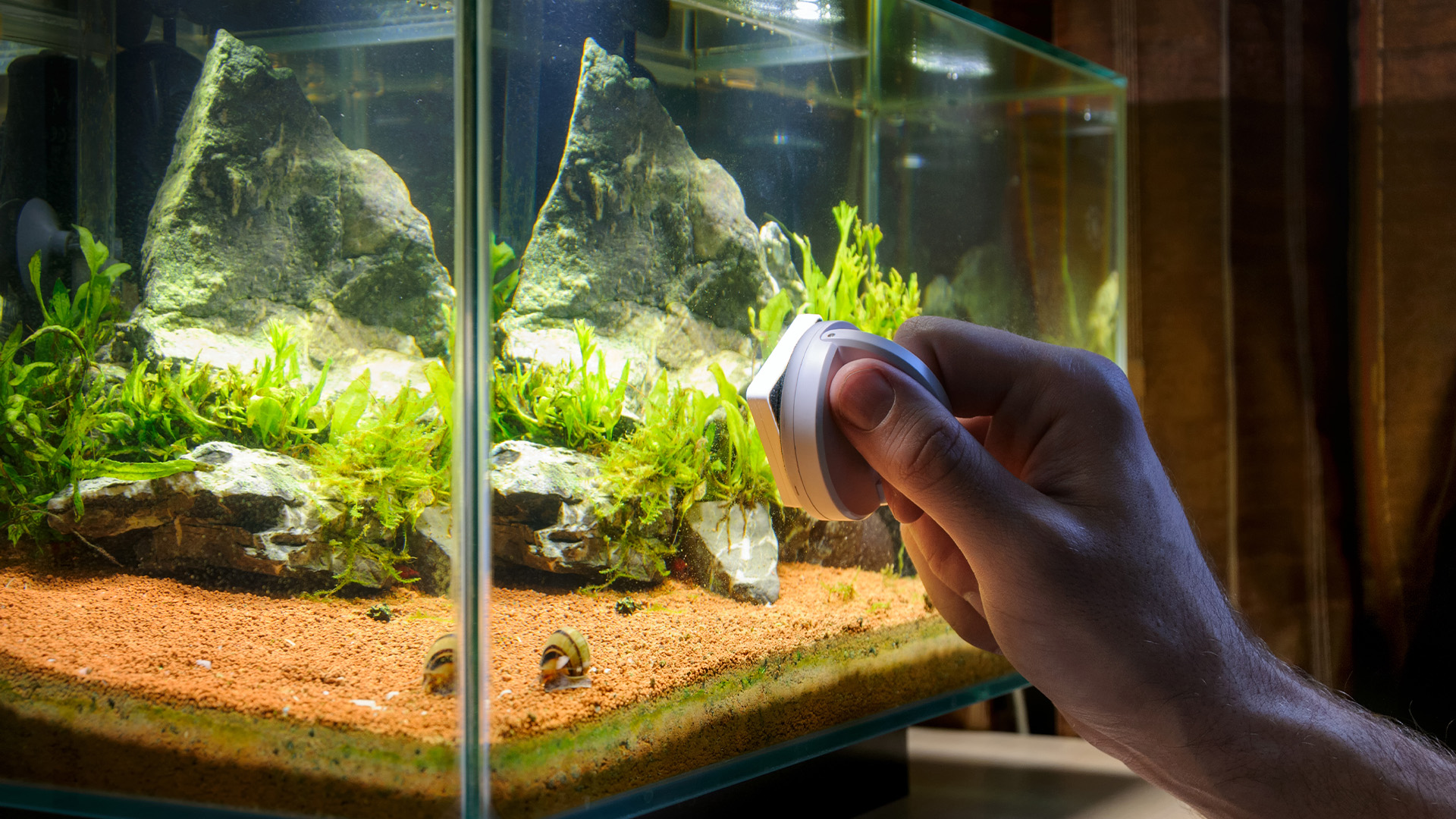How to clean a fish tank in 6 simple steps
From finding the products you'll need to the actual steps to take, here's how to clean a fish tank

If you’ve never cleaned a fish tank before, it can seem a daunting task. But fear not, we’re here to break it down into a simple step-by-step plan, with guidance on how to clean the whole thing, from the gravel to the glass.
Like the models in our round up of best fish tanks, your fish tank is an investment so it pays to take care of it. And even more importantly, keeping your tank in tip top condition plays an important role in keeping your fish happy and healthy. Dirty surroundings can stress your fish out and lead to illness, so let's tackle exactly how to clean a fish tank from top to bottom (and even in between the gravel and your best fish tank decorations).
To find out more on why you need to clean your fish tank, and the best way to go about it, we spoke with vet Dr Rebecca MacMillan.
Why do fish tanks need cleaning?
“Keeping a fish tank clean is essential for the health and well-being of your fish. It will also keep your tank looking good, making it an attractive feature in your home,” explains Dr MacMillan.
What do you use to clean a fish tank?
Before you head to your own cleaning cupboard, stop! You’ll need to stock up on some fish safe cleaners which won’t harm your pets. You’ll also likely need some specific equipment and cleaners, as the different elements of your tank will need to be cleaned differently.
Here's a complete list of items you'll need to properly clean your fish tank:
- Algae cleaner/scraper (like this one on Amazon)
- Gravel vacuum (like this one on Amazon)
- Bucket (a collapsible bucket like this one is ideal for storing)
- Aquarium-safe glass cleaner (this one from API features in our guide to the best fish tank cleaners)
- Old bath towels
- Paper towels
- Filter brush (like this one on Amazon)
- Water conditioning solution (like this one on Amazon)
How to clean a fish tank: Preparation
Once you’ve got your gear ready, it’s time to prep your tank ready for cleaning. Dr MacMillan shared with us how to do this:
Get the best advice, tips and top tech for your beloved Pets
- Wash your hands and arms: Before cleaning your tank, make sure that you have washed your hands and arms. This ensures that you don’t accidentally contaminate the water with anything that might be on your skin.
- Turn it off: Turn off any electrical items, including the light and filter.
- Remove decor: Remove any artificial plants or easily moveable decorative features. These can then be cleaned elsewhere using aquarium-safe cleaning solutions.
How to clean a fish tank: Step-by-step
It's easiest if you clean a fish tank in a particular order. Believe it or not, you can leave your fish in the tank while you clean it – removing them from the tank can stress them out, and you could accidentally injure them. You don't need to fully drain the tank of water, so the fish can remain in situ. Completely replacing the water in the tank can actually shock your fish.
Cleaning your fish tank in a particular order will make the process easier and more efficient and will also decrease the likelihood of you disturbing your fish or accidentally upending the balance of bacteria in the tank's water. There is beneficial bacteria inside fish tanks that should remain there, and doing things like cleaning a filter at the same time you clean your entire tank can trigger an ammonia spike, which can be fatal for fish.
Step 1: How to clean fish tank glass
The first step is cleaning the glass. For this, you’ll need an algae scraper or pad. “You should scrub the inside walls of your tank with a cleaning sponge or algae scraper made specifically for this purpose. This will lift any algae without scratching the glass,” advises Dr MacMillan.
Step 2: How to clean fish tank decorations
During the prep stage you will have already removed all of the decorations, including fake plants, rock decor and any other such features. Whatever you do, don’t clean these with soap as it is almost impossible to remove entirely and can have harmful side effects for fish.
Simply soak the decorations in warm water and use the sponge or algae scraper to scrape away the algae. For stubborn algae you can use a 10% bleach and water solution, but these must be thoroughly rinsed in water and left to air dry afterwards. This should eliminate as much of the bleach as possible, though if it still smells like bleach avoid putting it back in the tank.
Step 3: How to clean fish tank gravel
While your decorations are air drying, it’s time to clean the fish tank gravel. “Most fish tanks can be cleaned using an aquarium gravel vacuum to siphon the dirty water from the tank into a bucket or a drain,” says Dr MacMillan.
The siphon moves the gravel around and vacuums up any debris kicked up, without vacuuming up the gravel.
In order to do this: “direct the nozzle of the vacuum into all areas of the tank to suction up all the loose debris and dirt. When removing water, ensure that you take no more than 50% out of the tank. This helps the tank to maintain its stable water parameters and bacteria levels. Your fish will stay in the tank while you are cleaning it, so this is another reason why it is important not to take too much water out,” she explains.
Step 4: How to clean the water in your fish tank
Once you have removed around 50% of the water, it’s time to top the tank back up. But don’t just chuck a bucket load of tap water straight in.
“When replacing the water, make sure you have treated it with a water conditioning solution. Chlorine levels in tap water can be too high for fish, so this makes things safer for them,” explains Dr MacMillan. “You should also ensure the clean water is at the correct temperature before gently pouring it in so that you don’t shock or injure your fish. You may also want to consider adding some anti-algae solution to your water to discourage algae growth,” she adds.
Step 5: How to clean the water filter in your fish tank
“Don’t forget that your filter will also need regular cleaning and maintenance to ensure that it continues performing well. This should also be part of your tank cleaning regime,” advises Dr MacMillan.
You'll want to wait to clean the filter until two weeks after you cleaned all of the other fish tank elements. Not waiting can further disturb the tank's bacteria, much of which is beneficial for your fish.
If you have filter media that contains carbon, ammonia absorbers, or ion-exchange resins, it should be replaced if it's more than three weeks old. If you have a filter that is mechanical and does not absorb toxins like a filter fiber, sponges, or a ceramic filter, you can gently rinse it and place it back in the filter. Clean the filter tubing and other parts of the filter that are in the tank's water with a filter brush.
Step 6: How to clean the outside glass
Even though it’s the exterior, you should only use aquarium safe cleaners to clean the outside glass, as ammonia is very toxic to fish. You can also use vinegar. When cleaning the glass and other fixtures, make sure to clean the hood, light, and top of the tank as well. Then go over everything you've cleaned with a damp cloth or wet paper towel.
There you have it – a step by step guide to cleaning your fish tank. All that’s left to do now is step back and admire your hard work (and, of course, your fish).
Wondering why your fish tank is cloudy? Or looking for tips for taking care of fish? We’ve got it all!

Dr MacMillan is a companion animal vet who has always had a passion for writing and client communication. She works in the south west of England and loves complex medical cases.

Abby is a freelance writer and dog owner. She currently has two golden retrievers, Lowen and and Indy, but has previously had many other pets, including rabbits.
Abby has written for Metro, House Beautiful, Fit+Well, and more. Alongside this, Abby also volunteers at a local dog rescue centre, helping out with daily activities, such as walking, feeding and grooming.
